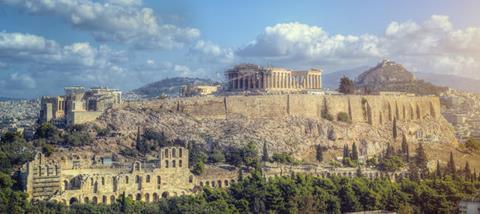
I’m a sucker for anything ancient; a real enthusiast for the classical world. So naturally I expected a trip to Athens to be enthralling, and it didn’t disappoint. What I didn’t expect was a new insight into a familiar Bible passage, which would give me a glimpse of the character of God.
Athens is a city in which ancient temples peep shyly from between congested dual carriageways, and traders hawk replica Greek vases at the locations from which their ancestors sold the originals thousands of years earlier. It has been occupied for longer than human history records and Athenians are very comfortable living side by side with layers of their history, but it can be quite disconcerting for a newcomer. It’s like seeing the edges of modernity peel away and becoming aware that history is peeking through. The connection to the past is palpable.
Everywhere you go, across the crowded squares and chasm-like side streets, the Acropolis looks down on the city, just as it did when the apostle Paul visited 2,000 years ago.
BREATHTAKING RUINS
The crowning glory of the Acropolis is the Parthenon. Everyone has seen the Parthenon, whether they have been to Greece or not. Like the Colosseum, the pyramids and the Twin Towers, it has been implanted into our psyche (a good Greek word) through pictures and films. But nothing compares to seeing it in real life. The grace, the scale and the perfection of it takes your breath away. The Parthenon was the pinnacle of human achievement at the time, and even in its semi-ruined state it’s impossible not to admire it.
Although dedicated to Athena (the Parthenos is a virgin goddess), it is really a tribute to the creative powers of human beings. These days there is no giant statue of Athena looking down on worshippers from within the temple, but it still has an air of majesty.
STANDING ON THE AREOPAGUS
Across from the Acropolis is another hill, dedicated to another Greek god: the Areopagus; the Hill of Ares. Along with many other tourists on a hot day, I climbed this hill to see the site of ancient court cases and council discussions, but, more significantly for a Christian, the place where Paul gave his famous speech about the ‘unknown god’ to the Athenians (Acts 17). I had heard the line ‘God…does not live in temples built by human hands’ many times, and I was quite happy to agree. But we don’t really have temples any more; nor do we have the huge idols inside them. It seemed more like a truism than a divine revelation.
However, standing on the Areopagus in front of a brass plaque inscribed with Paul’s sermon, these words took on a whole new level of meaning for me. Towering over the hill, the plaque and the tourists was the Parthenon, and I finally understood what Paul was saying. Paul, a non-Greek, a ‘mere’ Jew, had stood in front of the Parthenon – the greatest temple in the world – and spoken these words.
Perhaps he gestured behind him at the towering columns as he said: ‘The God who made the world and everything in it is the Lord of heaven and earth and does not live in temples built by human hands.’ (Acts 17:24).
AWESTRUCK BY GLORY
As I looked at the plaque and the Parthenon I was awestruck by Paul’s audacity and also by the truth of his words. Even our best efforts, even our greatest achievements, even the Parthenon, cannot compare to God. Not because they are not great, but because he is so much greater. The Athenians had tried to depict divine majesty, but Paul was talking about the real thing.
I picked my way back down that steep hill feeling humbled and stilled. The Parthenon, one of humanity’s greatest achievements, had taken my breath away. However, God had used it to show me, just as he had shown Paul, how much higher, deeper and wider is the glory of God than anything we can imagine.
Karen Muradarasi is the winner of Premier Christianity’s travel writing competition and will enjoy a retreat at Lee Abbey. Our runner-up, Mark Elder, will receive a month’s supply of Jude’s ice cream. Find Mark’s entry here.



























